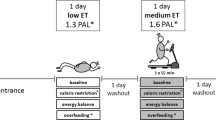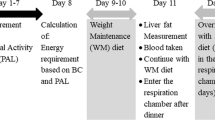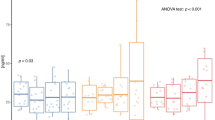Abstract
Objective:
To determine the role of macronutrients oxidation ability in the postprandial response to a high lipid load in the mechanisms conferring resistance or susceptibility to obesity.
Subjects and design:
Nine lean and nine obese young male subjects with habitual similar high-fat intake (>40 % of energy) and comparable physical activity were selected and categorized as ‘resistant’, those who remained lean (body mass index (BMI) <25 kg/m2), and ‘susceptible’, those who were obese (BMI>30 kg/m2). Fasting blood samples were taken for the evaluation of blood metabolic and hormonal variables. Resting metabolic rate (RMR) and substrates oxidation were measured by indirect calorimetry, in the fasting state and every 30 min for 3 h after a rich lipid meal (fat 94.7%) supplied to cover the 50% of the volunteers energy requirements. The study was performed at the Metabolic Unit of the University of Navarra.
Results:
Fasting RMR and lipid oxidation were higher in obese–susceptible subjects. However, similar values were found in both groups after adjustment for fat mass and free fat mass. The cumulative postprandial fat oxidation was also similar in both groups (despite having different tissue metabolic activity), whereas cumulative carbohydrate oxidation was lower in the obese–susceptible group. The thermic effect of food (% of dietary induced thermogenesis) was lower (P<0.05) in the susceptible–obese subjects. The energy and fat balance were more positive in the obesity-susceptible individuals after the high fat load, who also showed higher fasting homeostatic model assessment index, low-density lipoprotein-cholesterol and triacylglyceride levels, hyperleptinemia and hypoadiponectinemia.
Conclusion:
Lean–resistant individuals came closer to achieving fat balance than obese–susceptible subjects. These metabolic and hormonal differences are probably genetically determined.
This is a preview of subscription content, access via your institution
Access options
Subscribe to this journal
Receive 12 print issues and online access
$259.00 per year
only $21.58 per issue
Buy this article
- Purchase on Springer Link
- Instant access to full article PDF
Prices may be subject to local taxes which are calculated during checkout



Similar content being viewed by others
References
Acheson KJ, Schutz Y, Bessard T, Anantharaman K, Flatt JP, Jequier E (1988). Glycogen storage capacity and de novo lipogenesis during massive carbohydrate overfeeding in man. Am J Clin Nutr 48, 240–247.
Achten J, Jeukendrup AE (2004). Optimizing fat oxidation through exercise and diet. Nutrition 20, 716–727.
Astrup A, Buemann B, Christensen NJ, Toubro S (1994). Failure to increase lipid oxidation in response to increasing dietary fat content in formerly obese women. Am J Physiol 266, 592–599.
Astrup A, Buemann B, Toubro S, Ranneries C, Raben A (1996). Low resting metabolic rate in subjects predisposed to obesity: a role for thyroid status. Am J Clin Nutr 63, 879–883.
Auwerx J, Staels B (1998). Leptin. Lancet 7, 737–742.
Bendixen H, Flint A, Raben A, Hoy CE, Mu H, Xu X et al. (2002). Effect of 3 modified fats and a conventional fat on appetite, energy intake, energy expenditure, and substrate oxidation in healthy men. Am J Clin Nutr 75, 47–56.
Blundell JE, Macdiarmid JI (1997). Passive overconsumption. Fat intake and short-term energy balance. Ann NY Acad Sci 20, 392–407.
Bray GA, Paeratakul S, Popkin BM (2004). Dietary fat and obesity: a review of animal, clinical and epidemiological studies. Physiol Behav 30, 549–555.
Chang S, Graham B, Yakubu F, Lin D, Peters JC, Hill JO (1990). Metabolic differences between obesity-prone and obesity-resistant rats. Am J Physiol 259, 1103–1110.
De Jonge L, Bray GA (1997). The thermic effect of food and obesity: a critical review. Obes Res 5, 622–631.
De Jonge L, Bray GA (2002). The thermic effect of food is reduced in obesity. Nutr Rev 60, 295–297.
Elia M, Livesey G (1992). Energy expenditure and fuel selection in biological systems: the theory and practice of calculations based on indirect calorimetry and tracer methods. In: Simopoulus AP (ed). Metabolic Control of Eating, Energy Expenditure and the Bioenergetics of Obesity. World Review of Nutrition and Dietetics, vol. 70. Basel: Karger, pp 68–131.
Flatt JP (1987). The difference in the storage capacities for carbohydrate and for fat, and its implications in the regulation of body weight. Ann NY Acad Sci 499, 104–123.
Fruebis J, Tsao TS, Javorschi S, Ebbets-Reed D, Erickson MR, Yen FT et al. (2001). Proteolytic cleavage product of 30-kDa adipocyte complement-related protein increases fatty acid oxidation in muscle and causes weight loss in mice. Proc Natl Acad Sci USA 13, 2005–2010.
Giacco R, Clemente G, Busiello L, Lasorella G, Rivieccio AM, Rivellese AA et al. (2004). Insulin sensitivity is increased and fat oxidation after a high-fat meal is reduced in normal-weight healthy men with strong familial predisposition to overweight. Int J Obes Relat Metab Disord 28, 342–348.
Granata GP, Brandon LJ (2002a). The thermic effect of food and obesity: discrepant results and methodological variations. Nutr Rev 60, 223–233.
Granata GP, Brandon LJ (2002b). Methodological variations and inconsistencies compromise the science of examining the thermic effect of food. Nutr Rev 60, 299–300.
Havel PJ (2004). Update on adipocyte hormones: regulation of energy balance and carbohydrate/lipid metabolism. Diabetes 53 (Suppl 1), S143–S151.
Hotta K, Funahashi T, Bodkin NL, Ortmeyer HK, Arita Y, Hansen BC (2001). Circulating concentrations of the adipocyte protein adiponectin are decreased in parallel with reduced insulin sensitivity during the progression to type 2 diabetes in rhesus monkeys. Diabetes 50, 1126–1133.
Jeffery RW, Wing RR, Sherwood NE, Tate DF (2003). Physical activity and weight loss: does prescribing higher physical activity goals improve outcome? Am J Clin Nutr 78, 684–689.
Johansson L, Solvoll K, Bjorneboe GE, Drevon CA (1998). Under- and overreporting of energy intake related to weight status and lifestyle in a nationwide sample. Am J Clin Nutr 68, 266–274.
Kubota N, Terauchi Y, Yamauchi T, Kubota T, Moroi M, Matsui J et al. (2002). Disruption of adiponectin causes insulin resistance and neointimal formation. Biol Chem 277, 25863–25866.
Kumada M, Kihara S, Sumitsuji S, Kawamoto T, Matsumoto S, Ouchi N et al. (2003). Association of hypoadiponectinemia with coronary artery disease in men. Arterioscler Thromb Vasc Biol 23, 85–89.
Kunz I, Schorr U, Rommling K, Klaus S, Sharma AM (2002). Habitual fat intake and basal fat oxidation in obese and non-obese Caucasians. Int J Obes Relat Metab Disord 26, 150–156.
Labayen I, Diez N, Parra D, Gonzalez A, Martinez JA (2004). Basal and postprandial substrate oxidation rates in obese women receiving two test meals with different protein content. Clin Nutr 23, 571–578.
Leibel RL, Rosenbaum M, Hirsch J (1995). Changes in energy expenditure resulting from altered body weight. N Engl J Med 9, 621–628.
Lichtman SW, Pisarska K, Berman ER, Pestone M, Dowling H, Offenbacher E et al. (1992). Discrepancy between self-reported and actual caloric intake and exercise in obese subjects. N Engl J Med 31, 1893–1898.
Lissner L, Heitmann BL (1995). Dietary fat and obesity: evidence from epidemiology. Eur J Clin Nutr 49, 79–90.
Macdiarmid JI, Cade JE, Blundell JE (1996). High and low fat consumers, their macronutrient intake and body mass index: further analysis of the National Diet and Nutrition Survey of British Adults. Eur J Clin Nutr 50, 505–512.
Maeda N, Shimomura I, Kishida K, Nishizawa H, Matsuda M, Nagaretani H (2002). Diet-induced insulin resistance in mice lacking adiponectin/ACRP30. Nat Med 8, 731–737.
Marques-Lopes I, Ansorena D, Astiasaran I, Forga L, Martinez JA (2001). Postprandial de novo lipogenesis and metabolic changes induced by a high-carbohydrate, low-fat meal in lean and overweight men. Am J Clin Nutr 73, 253–261.
Marques-Lopes I, Forga L, Martinez JA (2003). Thermogenesis induced by a high-carbohydrate meal in fasted lean and overweight young men: insulin, body fat, and sympathetic nervous system involvement. Nutrition 19, 25–29.
Marrades MP, Milagro FI, Martinez JA, Moreno-Aliaga MJ (2006). Differential expression of aquaporin 7 in adipose tissue of lean and obese high fat consumers. Biochem Biophys Res Commun 339, 785–789.
Marti A, Moreno-Aliaga MJ, Hebebrand J, Martinez JA (2004). Genes, lifestyles and obesity. Int J Obes Relat Metab Disord 28 (Suppl 3), S29–S36.
Martinez JA (2000). Obesity in young Europeans: genetic and environmental influences. Eur J Clin Nutr 54 (Suppl 1), S56–S60.
Martinez-Gonzalez MA, Martinez JA, Hu FB, Gibney MJ, Kearney J (1999). Physical inactivity, sedentary lifestyle and obesity in the European Union. Int J Obes Relat Metab Disord 23, 1192–1201.
Matthews DR, Hosker JP, Rudenski AS, Naylor BA, Treacher DF, Turner RC (1985). Homeostasis model assessment: insulin resistance and beta-cell function from fasting plasma glucose and insulin concentrations in man. Diabetologia 53, 412–419.
Moreno-Aliaga MJ, Santos JL, Marti A, Martinez JA (2005). Does weight loss prognosis depend on genetic make-up? Obes Rev 6, 155–168.
Perez-Echarri N, Perez-Matute P, Martinez JA, Marti A, Moreno-Aliaga MJ (2005). Serum and gene expression levels of leptin and adiponectin in rats susceptible or resistant to diet induced obesity. J Physiol Biochem 61, 333–342.
Pischon T, Girman CJ, Hotamisligil GS, Rifai N, Hu FB, Rimm EB (2004). Plasma adiponectin levels and risk of myocardial infarction in men. JAMA 291, 1730–1737.
Prentice AM, Sonko BJ, Murgatroyd PR, Goldberg GR (1994). Obesity as an adaptation to a high-fat diet. Am J Clin Nutr 60, 640–642.
Qi Y, Takahashi N, Hileman SM, Patel HR, Berg AH, Pajvani UB et al. (2004). Adiponectin acts in the brain to decrease body weight. Nat Med 10, 524–529.
Raben A, Agerholm-Larsen L, Flint A, Holst JJ, Astrup A (2003). Meals with similar energy densities but rich in protein, fat, carbohydrate, or alcohol have different effects on energy expenditure and substrate metabolism but not on appetite and energy intake. Am J Clin Nutr 77, 91–100.
Ravussin E (1995). Low resting metabolic rate as a risk factor for weight gain: role of the sympathetic nervous system. Int J Obes Relat Metab Disord 19 (Suppl 7), S8–S9.
Ravussin E, Gautier JF (1999). Metabolic predictors of weight gain. IntJ Obes Relat Metab Disord 23 (Suppl 1), S37–S41.
Reed GW, Hill JO (1996). Measuring the thermic effect of food. Am J Clin Nutr 63, 164–169.
Sanchez-Villegas A, Delgado-Rodriguez M, Martinez-Gonzalez MA, De Irala-Estevez J, Seguimiento Universidad de Navarra group (2003). Gender, age, socio-demographic and lifestyle factors associated with major dietary patterns in the Spanish Project SUN (Seguimiento Universidad de Navarra). Eur J Clin Nutr 57, 285–292.
Schrauwen P, van Marken Lichtenbelt WD, Westerterp KR (2000). Fat and carbohydrate balances during adaptation to a high-fat diet. Am J Clin Nutr 72, 1239–1241.
Schutz Y (1995). Macronutrients and energy balance in obesity. Metabolism 44, 7–11.
Schutz Y (2004). Concept of fat balance in human obesity revisited with particular reference to de novo lipogenesis. Int J Obes Relat Metab Disord 28 (Suppl 4), S3–S11.
Schutz Y, Tremblay A, Weinsier RL, Nelson KM (1992). Role of fat oxidation in the long-term stabilization of body weight in obese women. Am J Clin Nutr 55, 670–674.
Segal KR, Edano A, Blando L, Pi-Sunyer FX (1990a). Comparison of thermic effects of constant and relative caloric loads in lean and obese men. Am J Clin Nutr 51, 14–21.
Segal KR, Edano A, Tomas MB (1990b). Thermic effect of a meal over 3 and 6 hours in lean and obese men. Metabolism 39, 985–992.
Smith SR, de Jonge L, Zachwieja JJ, Roy H, Nguyen T, Rood JC et al. (2000). Fat and carbohydrate balances during adaptation to a high-fat. Am J Clin Nutr 71, 450–457.
Stefan N, Bunt JC, Salbe AD, Funahashi T, Matsuzawa Y, Tataranni PA (2002). Plasma adiponectin concentrations in children: relationships with obesity and insulinemia. J Clin Endocrinol Metab 87, 4652–4656.
Thomas CD, Peters JC, Reed GW, Abumrad NN, Sun M, Hill JO (1992). Nutrient balance and energy expenditure during ad libitum feeding of high-fat and high-carbohydrate diets in humans. Am J Clin Nutr 55, 934–942.
Wadden TA, Butryn ML, Byrne KJ (2004). Efficacy of lifestyle modification for long-term weight control. Obes Res 12 (Suppl 15), S1–S62.
Westerterp-Plantenga MS, Pasman WJ, Yedema MJ, Wijckmans-Duijsens NE (1996). Energy intake adaptation of food intake to extreme energy densities of food by obese and non-obese women. Eur J Clin Nutr 50, 401–407.
World Health Organization (1985). Energy and protein requirements. Report of joint FAO/WHO/UNU expert consultation. In: WHO Technical Report Series No. 724. World Health Organization: Geneva, Switzerland.
Zurlo F, Lillioja S, Esposito-Del Puente A, Nyomba BL, Raz I, Saad MF et al. (1990). Low ratio of fat to carbohydrate oxidation as predictor of weight gain: study of 24 h RQ. Am J Physiol 259, 6500–6507.
Acknowledgements
We thank the Government of Navarra (Health Department) for supporting this work included in the Linea Especial of the University of Navarra (LE/97).
Author information
Authors and Affiliations
Corresponding author
Additional information
Guarantor: JA Martínez.
Rights and permissions
About this article
Cite this article
Marrades, M., Martínez, J. & Moreno-Aliaga, M. Differences in short-term metabolic responses to a lipid load in lean (resistant) vs obese (susceptible) young male subjects with habitual high-fat consumption. Eur J Clin Nutr 61, 166–174 (2007). https://doi.org/10.1038/sj.ejcn.1602500
Received:
Revised:
Accepted:
Published:
Issue Date:
DOI: https://doi.org/10.1038/sj.ejcn.1602500
Keywords
This article is cited by
-
Effect of macronutrient composition on meal-induced thermogenesis in adolescents with obesity
European Journal of Nutrition (2019)
-
Orchestrated downregulation of genes involved in oxidative metabolic pathways in obese vs. lean high-fat young male consumers
Journal of Physiology and Biochemistry (2011)
-
ZAG, a lipid mobilizing adipokine, is downregulated in human obesity
Journal of Physiology and Biochemistry (2008)



